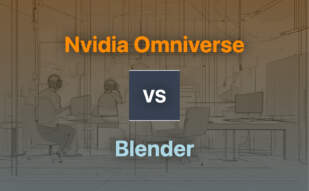Nvidia Omniverse is a Universal Scene Description (OpenUSD)-based 3D computing platform that combines NVIDIA RTX technology with USD for scalable 3D workflows transformation. With options ranging from standard to Enterprise and Cloud licenses, developers can leverage over 20 years of NVIDIA AI, rendering, and simulation technology.
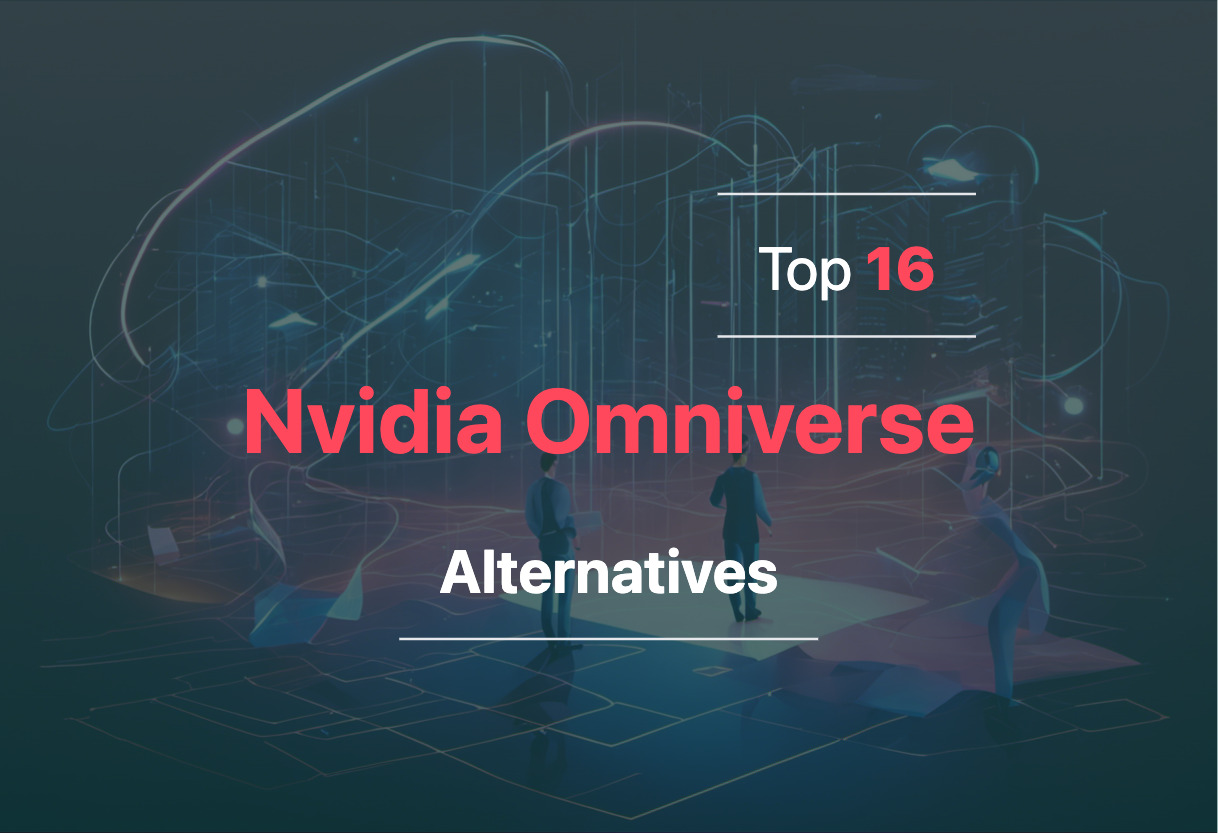
For those exploring alternatives to Nvidia Omniverse, options include Unity, Unreal Engine, Unity Reflect, Facebook Metaverse, Blender, Metaverse, Unreal Engine 5, O3DE, Open 3D Engine, Stride, Babylon.js, Three.js, jMonkeyEngine, Roblox, SpriteKit, and Defold.
Unity

Championing the realm of game development since 2005, Unity empowers creators with robust tools for crafting 3D and 2D games. Known for its compatibility with diverse platforms and revolutionary approach to pricing, Unity stands as a worthy alternative in the 3D Graphics & Modeling industry.
Unity’s Top Features
- Cross-platform game launching.
- End-to-end AR/VR development solutions.
- Rich asset store with pre-designed textures and functionalities.
- Multi-language coding support, including BOO Script, JavaScript, and C#.
- Active developer community for continuous feedback and problem solving.
| Feature | Description |
|---|---|
| Adaptability | Supports a multitude of operating systems, enabling diversified application creation. |
| Rendering technology | Facilitates high-quality game creation with advanced rendering. |
| Continuous tech evolution | Ensures user-friendly, compatible, and visually immersive experiences. |
Unity’s Limitations
- New per-install fee pricing structure expected to be detrimental to small-scale, independent, and mobile developers.
- Retroactive open fees create friction and mistrust among users.
- Unannounced changes and sudden shifts in pricing endanger financial sustainability of developers.
Unity Pricing
Launching a new pricing model starting January 1, 2024, Unity introduces a per-install fee. However, the free and paid versions remain available, with fees applicable only after the game’s revenues and installations cross $200,000 and 200,000 respectively. Note: Unity has discontinued its Plus subscription tier.
Unity Use Cases
Desktop and Mobile Game Developers
Unity’s adaptable interface, cross-platform support, and rich asset store make it a prime choice for desktop and mobile game developers.
AR/VR Content Creators
With integrated tools conducive for AR/VR development, Unity optimizes creation of immersive experiences.
Indie Developers
Despite the pricing shift, the free-tiered offering, thriving community support, and continuous innovation make Unity a viable option for indie developers striving for sophistication in their games.
Unreal Engine
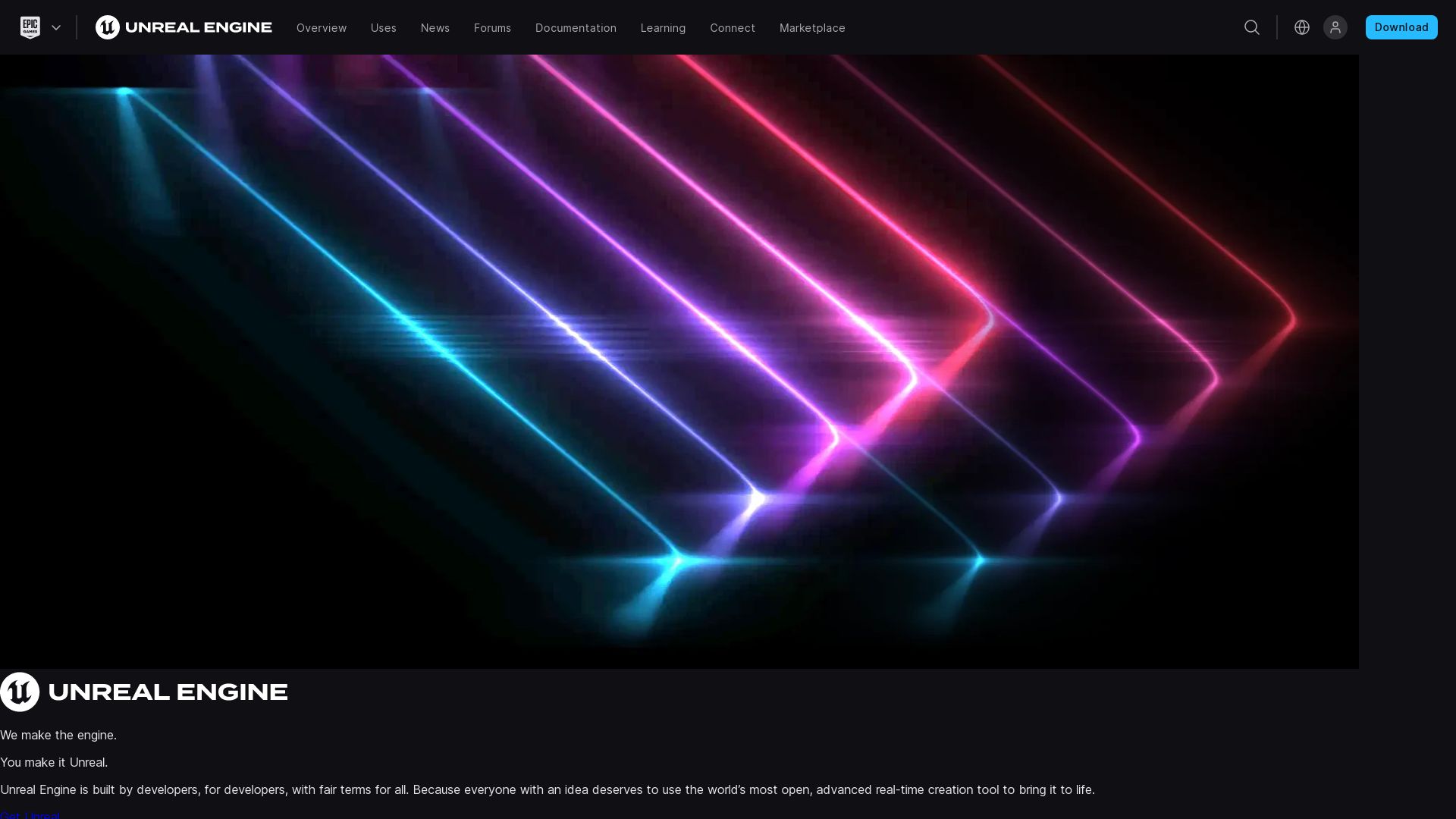
Developed by Epic Games, Unreal Engine (UE) is a proficient line of 3D computer graphics game engines, introduced in 1998 with the release of the eponymous game, Unreal. Written in C++, UE holds the capacity to support a wide spectrum of platforms inclusive of desktop, mobile, console, and VR platforms. The engine has progressively evolved, evidenced by the most recent release of Unreal Engine 5 in April 2022.
Unreal Engine Top Features
- Wide Platform Support: UE supports a wide array of platforms, including desktop, mobile, console, and virtual reality systems.
- Real-time Constructive Solid Geometry Operations: The level editor, UnrealEd, facilitates these operations enhancing the application’s versatility.
- Modder-Friendly Environment: Unreal Engine 3 granted complete accessibility for modders.
- Unreal Development Kit: A free version of UE3’s SDK. It empowers creators by offering support for iOS games and apps.
- Marketplace: It allows users to sell their creations or purchase the work of other developers, with a substantial 88% revenue share for content creators.
| Free for Educational Use | UE is available free of cost for schools and universities. |
| Basic Project Templates | Offers a template serving as a foundation for a first or third-person experience. |
| Global Presence | Through strategic alliances, Epic Games seeks to popularize UE worldwide. |
Unreal Engine Limitations
- Some aspects of its programming can be complex for beginners, particularly with the tool’s C++ language for development.
- Royalty charges apply for commercial use: Epic Games charges 5% of revenues over USD 1 million.
- Certain features might require additional costs, adding to overhead expenses.
Unreal Engine Pricing
Unreal Engine is available free of charge for all users. However, Epic Games enforces a 5% royalty fee for products that generate more than $3,000 per quarter.
Unreal Engine Use Cases
Game Development
From PC first-person shooters to mobile games, UE offers a robust set of tools for game developers working across various genres.
Film and Television
The engine’s 3D graphics capability is equally useful in the film and television industry, offering impressive visual effects.
Academia
Its free availability for educational institutions makes UE an essential teaching and learning tool in computer graphics and game design curricula.
Babylon.js
Supervised by tech giant Microsoft and led by David Catuhe, Babylon.js is a 3D engine that utilises JavaScript and TypeScript capabilities to deliver stunning 3D graphics in real-time via HTML5, directly in your web browser.
Babylon.js Top Features
- Open Source: Provided under the Apache License 2.0, Babylon.js boasts a central repository hosted on GitHub. Developers can partake in the rule of code, propelling enhancements and bug fixes.
- Cross-Browser Support: Paves the way for compatible implementation across browsers that support WebGL and HTML5. Permits developers to create rich, interactive 3D experiences for all users.
- Physics Engine Options: Equips developers with plug-in physics engines like Cannon.js and Oimo to perfectly emulate real-world physical reactions and collisions.
- Flexible Animation: Makes room for varying animation techniques, allowing developers to do character animations via skeletal structures with blend weights.
| Modelling Process | Rendering Process |
|---|---|
| Employs polygon modelling with triangular faces and limited constructive solid geometry. | Revolutionary rendering on HTML 5 canvas element, with rendered pixel positions and its color set by shader program. |
| Applicable for complex 3D model creation. | Implements physically based rendering and post-processing for photorealistic images. |
Babylon.js Limitations
- Scope of Constructive Solid Geometry: Limited utility for union, subtraction and intersection of shell models- could impede complex modelling scenarios.
- Learning Curve: Intricacies, with TypeScript and Web GL, may present a steep learning curve for beginners.
Babylon.js Pricing
Babylon.js comes as an open-source project, free to use by developers and businesses alike, fostering an environment of collaborative development thanks to its Apache License 2.0.
Babylon.js Use Cases
Use case 1: Virtual World Creation
Babylon.js’s robust 3D engine and APIs furnish developers the power to create immersive virtual worlds, simulating high-geared engagements in gaming and interactive experience platforms.
Use case 2: Education
With realistic modelling, Babylon.js is an effective pedagogical tool in Medicine and other disciplines where intricate visual detail is essential for learning.
Use case 3: Fashion Avatars
Babylon.js’s controllable skeletal character animation allows for the creation of realistic fashion avatars, revolutionizing the digital fashion and e-commerce industry.
Three.js
Authored by Ricardo Cabello, Three.js is an efficient JavaScript library, enabling GPU-accelerated 3D animations within a web browser environment. It’s user-friendly and accessible, eliminating the need for browser plugins. Released initially in April 2010 and continually fostered by over 1700 contributors, this MIT licensed framework leverages WebGL and supports both Virtual and Augmented Reality via WebXR.
Three.js Top Features
- High-Level Libraries: Three.js, among others, simplifies the creation of complex 3D animations.
- WebGL 2.0 Usage: Ensuring up-to-date technology, Three.js shifted to WebGL 2.0 by default since version 118.
- Extensive Features: The framework offers multiple effects, scenes, cameras, materials, shaders, objects, geometry, and support options.
- VR and AR Support: Three.js provides Virtual and Augmented Reality capabilities through WebXR.
- Cross-Browser Compatibility: Three.js performs in all browsers that support WebGL 1.0.
| Feature | Benefits |
|---|---|
| Cross-Browser Compatibility | Wide accessibility, irrespective of users’ preferred browsers. |
| GPU-Accelerated Animations | Boosts the execution speed and ensures smooth animations. |
| Integration with WebXR | Enables the construction of immersive AR and VR experiences. |
Three.js Limitations
- Lack of a native physics engine, requiring integration with external libraries.
- The learning curve can be steep for beginners unfamiliar with 3D graphics or JavaScript.
Three.js Pricing
Bearing the MIT License, Three.js is open source which means it can be used free of charge.
Three.js Use Cases
Use Case 1 – Web-Based Video Game
Three.js enables developers to quickly prototype and develop interactive 3D video games that run directly in the browser.
Use Case 2 – AR/VR Experiences
With its support for WebXR, Three.js serves as an effective tool for creating immersive AR and VR experiences.
Use Case 3 – Data Visualization
Three.js offers a unique approach for visualizing complex datasets in 3D, providing unique insights and perspectives.
jMonkeyEngine
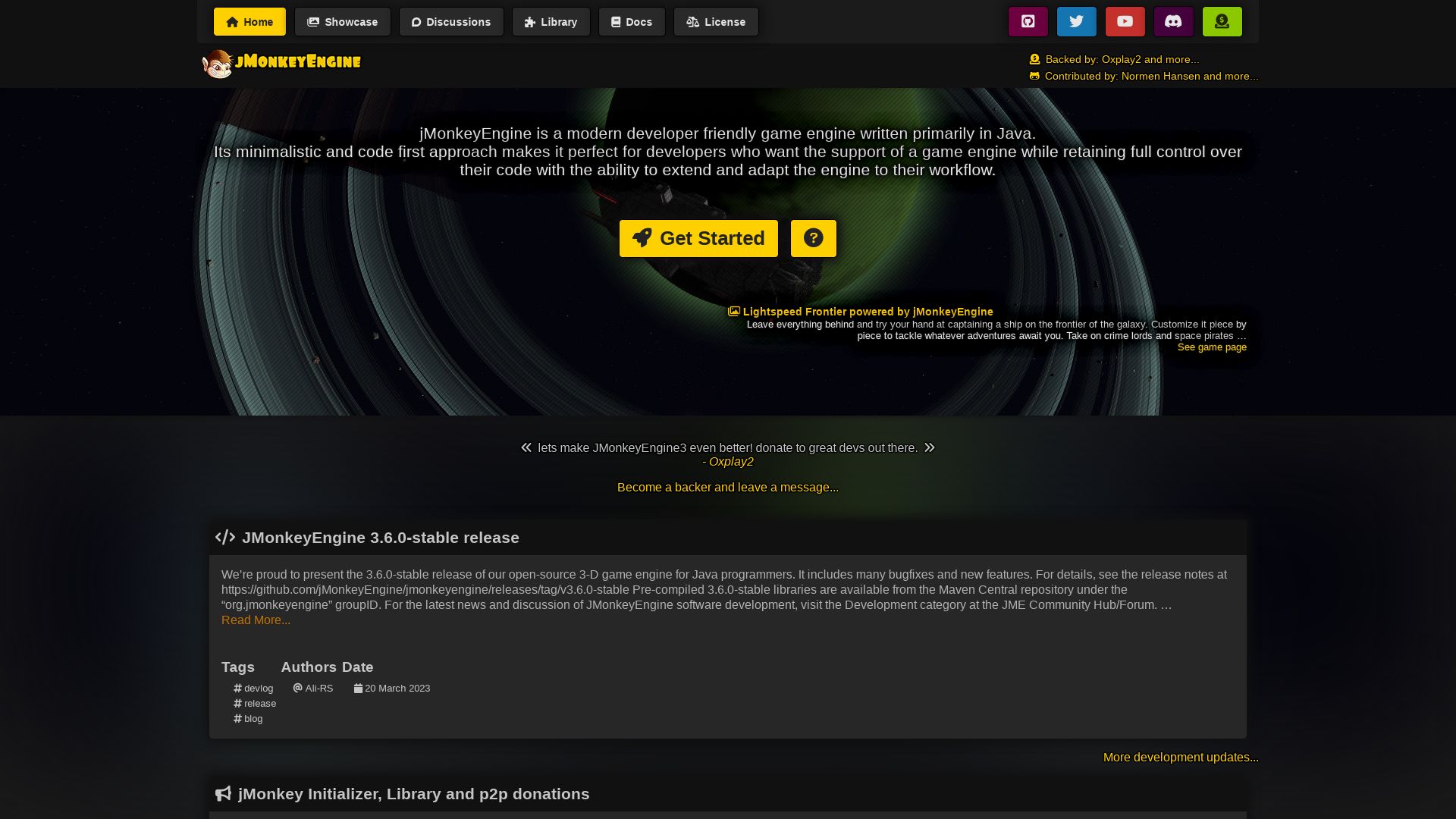
Cutting across realms of digital game creation, jMonkeyEngine presents immense capabilities for game development enthusiasts, and professionals alike. A robust, Java-based game engine, jMonkeyEngine infuses compatibility with the NetBeans Platform and Android, thereby expanding the scope for game developers across the globe.
jMonkeyEngine Top Features
- Open-source 3D game engine: Enter the exciting realm of 3D game programming with its 3.6.0-stable release, complete with a plethora of new features and bugfixes, all unleashed to your benefit on 20 March 2023.
- Advanced GUI and Audio options: From Lemur to Nifty GUI, IGUI, jMonkeyEngine breaks the norms with its variety in GUI. Coupled with rendering immersive sounds via OpenAL and jmePhonon, it gives your games a touch of realism.
- Out-of-the-box post-processing: With built-in filters like Bloom FXAA and light scattering, jMonkeyEngine paves the way for stunning graphics.
- Cross-platform compatibility: Compatible with PC, Linux, iOS, Android, and Mac, jMonkeyEngine ensures that no platform remains out of bounds for your gaming pursuits.
| Multiple networking options | Provides diverse choices including Spidermonkey, SimEthereal, Monkey Netty |
| Serious game development tool | Despite being a lower-level tool, it is capable of creating high-quality games, as exemplified by games developed using jMonkeyEngine, available widely on Steam, indiedb.com, and other platforms. |
| Learning material | Comprehensive documentation available online along with books for in-depth learning and YouTube tutorials for visual guidance, aiding beginners and professionals. |
jMonkeyEngine Limitations
- Despite its adaptable learning curve, it remains a lower-level game development tool.
- While it supports variety, it might not be equipped with advanced tools in comparison with competitors like Nvidia Omniverse.
jMonkeyEngine Pricing
An embracing welcome to free, open-source gaming technology under the permissive BSD 3-Clause license.
jMonkeyEngine Use Cases
Use case 1
jMonkeyEngine effectively caters to game-education programs, with its scope for easy adaptability making it a favorite among young and adult learners alike.
Use case 2
For developers looking to create cross-platform games with impressive post-process water and light scattering graphics, jMonkeyEngine is the tool of choice.
Use case 3
For indie game creators who prefer the open-source, community-supported model, jMonkeyEngine provides a strong framework for realization of creative gaming pursuits.
Roblox

Founded in 2004, Roblox is a significant player in the game development sphere, providing users with a comprehensive online platform for game creation and gameplay. It boasts an impressive user demographic with over 100 million active users globally as of 2021.
Roblox Top Features
- Robust Platform: Roblox uses its proprietary engine, Roblox Studio, and a Lua derivative, Luau, to enable seamless game creation.
- Diverse Content: The platform amplifies user-generated games, with a library extending over 50 million games.
- Social Interaction: Features such as friends addition and chat functionality foster user engagement.
- Collaborative Development: The platform champions unstructured play and collaborative development, promoting creativity.
- Robux Currency: In-app purchases are facilitated via a virtual currency, Robux, lucrative for creators.
| Feature | Description |
|---|---|
| Compatibility | Integrates with external software like Blender for modelling and animation. Broadens game development for various platforms such as Windows, macOS, iOS, Android, Xbox One, and more. |
| Safety Measures | Roblox takes player safety seriously, implementing algorithms to block sensitive personal information and inappropriate content. A public section, “For Parents,” provides insight into safety protocols. |
| Community Presence | Boasts a strong presence within social media spaces and YouTube tutorial communities, nurturing a sense of shared community among developers. |
Roblox Limitations
- Moderation Issues: The platform has faced criticism for issues relating to content moderation.
- Microtransactions: Users indicate a general dissatisfaction with the prevalence of in-app purchases.
- Adult Misuse: Reports of adult content misuse have thrown the platform’s safety measures into question.
Roblox Usage
The platform is free to use but incorporates an in-app purchase system facilitated using a virtual currency, Robux.
Roblox Use Cases
Use case 1 – Game Designers
With an easy-to-use engine and a vast content library, Roblox proves to be a solid choice for game designers looking to develop and test their creations among a large, active user base.
Use case 2 – Young Learners
Roblox’s strong commitment to safety makes it suitable for young learners to explore game design and development in a guarded digital environment.
Use case 3 – Independent Developers
Freelance developers and small businesses can leverage Roblox’s user-friendly platform to prototype and publish games, earning from in-app purchases.
SpriteKit
![]()
Brought to life by Apple, SpriteKit serves as a robust game development framework designed for iOS and macOS. It’s equipped with a range of user-friendly capabilities facilitating the creation of dynamic 2D games.
SpriteKit’s Top Features
- Effortless Game Creation: The framework is architected over SceneKit, making game creation seamless.
- Cross-platform Compatibility: SpriteKit allows developers to design and distribute games across different platforms with Game Center and iCloud support.
- Physics Engine: It employs the Box2D physics engine creating realistic object interactions.
- Supports Swift Language: Enhances code efficiency making game development faster and more efficient.
| Feature | Description |
|---|---|
| Scene, Node, Sprite, Action | Core components representing different aspects of the game allowing precise control. |
| SwiftUI and Swift Code Samples | SpriteKit provides samples to guide developers, easing the game creation process. |
| Scene Editing | A feature allowing for the construction of intricate game scenes. |
SpriteKit’s Limitations
- Platform Restriction: SpriteKit development is restricted to the Apple ecosystem, limiting its reach.
- Limited Shape Choices: For optimal performance, mainly circular shapes are supported, possibly affecting collision accuracy.
- Performance trade-off: Increasing collision accuracy through alpha masks can detrimentally affect performance.
SpriteKit Pricing
SpriteKit is available for free to developers within the Apple ecosystem.
SpriteKit Use Cases
Use case 1 – MVP game development
With capabilities like physics engine, textures, sprites, and particle system editors, it provides an apt platform for creating Minimum Viable Products (MVPs) in game development.
Use case 2 – Game analytics
Being a part of the Apple ecosystem, access to robust game analytics is assured, helping developers refine their games based on user interactions.
Use case 3 – Cross-platform game development
With iCloud and Game Center support, developers can create games that run seamlessly across iOS, macOS, offering a wider audience reach.
Defold

A product of Defold Foundation, Defold is a free, open-source game engine widely used for console, desktop, mobile, and web game development. Its foundation is rooted in the strong expertise of ex-Avalanche Studios employees and is known in the industry for its exemplary ease of use and technical documentation.
Defold Top Features
- Source code freely available on GitHub
- No initial costs, licensing fees, or royalties
- Built-in code editor, debugger, profiler, scene, and UI editors
- Flexible game logic system using Lua and native code
- Strong community support and frequent bi-weekly updates
| Additional Features | Benefits |
|---|---|
| Cross-platform building | Rapid and efficient deployment to multiple platforms |
| VSCode and CLI build system | Familiar interface for seasoned developers |
| Active open-source community | Collaborative enhancements and bug-fixing |
Defold Downsides
- Being primarily designed for 2D games, 3D development is ongoing and somewhat limited
- Because of a small development team, the scale of development may be limited
- Understanding of Defold, Native-Extensions, and flexible development capabilities is required for use
Defold Pricing
On top of being an effective gaming engine, Defold is completely free, significantly lowering the barrier of entry for developers.
Defold Use Cases
Use case 1
Creating cutting-edge 2D games: With its sophisticated engine and inherent Lua support, Defold is perfect for developers venturing into making commercial-grade 2D games.
Use case 2
Education and skill-building: Its simplicity and robust documentation make Defold a great tool for coding and game development in educational environments.
Use case 3
App development: Defold’s cross-platform capabilities and extensible native code features allow for rapid mobile and desktop app development.
Unity Reflect

Unity Reflect is a dynamic tool that bridges the gap between CAD/BIM and the Unity engine. With two versions in its suite, Reflect Review and Reflect Develop, it offers a range of outstanding features.
Unity Reflect Top Features
- Seamless CAD/BIM to Unity engine linking
- Multiple plugin support: Autodesk Revit/Navisworks/BIM 360/SketchUp/Rhino
- On-premise and cloud-hosted servers
- Multi-platform 3D project reviewing with AR/VR options
- Develop custom applications with SDK and APIs.
| Highly collaborative | Unity Reflect focuses on viewing across multiple devices and boasts enhanced multi-user collaboration, in-built voice chat/measurement tools, and multi-visibility options. |
| Flexible Licensing | Offers three license types: Review, Collaborate, Develop catering to different use-cases. |
| Consistent Enhancements | Unity Reflect evolves consistently, with plans to support more applications for improved flexibility and functionality. |
Unity Reflect Limitations
- Access restrictions: Project visibility is for logged in users only. Guest users consume a Collaborate license from the pool.
- Licensing limitations: Review/Develop licenses are user-specific, Collaborate licenses remain active while connected to Reflect Cloud. They expire after 25 days of inactivity.
Unity Reflect Pricing
The Reflect Review cost is $690/year. Also, there is the Reflect Collaborate at $149/year.
Unity Reflect Use Cases
Use case 1: AEC firms
AEC firms can leverage Unity Reflect for developing custom applications seamlessly atop the platform. The tool’s live link to original models enables real-time changes facilitating faster design iterations.
Use case 2: Software developers
Software developers benefit from open-sourced applications, APIs for BIM data import/streaming, and cross-platform app development, fostering innovative solutions.
Use case 3: Construction tracking with AR
Tracking construction progress with AR is feasible, as demonstrated by SHOP Architects. Accurate design visualization and acoustic simulations are thus enabled at every project level.
Facebook Metaverse
The Facebook Metaverse, a part of Meta, signifies the next evolution in social connection, taking the form of a VR space for multifaceted interaction. Conceived by Meta CEO, Mark Zuckerberg, Metaverse proposes a future of connection, immersive work & play, personalized shopping, and much more.
Facebook Metaverse Top Features
- Horizon Worlds: This VR social universe takes you to 10,000+ unique worlds/experiences.
- Horizon Workrooms: Replicating an in-person workplace, it offers business collaboration tools to facilitate a seamless professional environment.
- Horizon Venues: Event spaces computerized to give you access to virtual concerts and sports.
| Access Options | Description |
|---|---|
| VR Headsets | High-tech goggles such as Meta Quest for an immersive experience. |
| AR Gear | Overlay digital elements on the natural world for free-flowing movement. |
| Mobile Apps | No need for VR/AR to access the Metaverse, it’s in the palm of your hand. |
Facebook Metaverse Downsides
- Privacy concerns have riddled Facebook’s Metaverse, causing apprehension among many.
- The inability of the platform to solve online harm perpetuation is a significant drawback.
- There’s a prevalent tension between the open internet ideology and Facebook’s business model.
Facebook Metaverse Pricing
Facebook Metaverse’s pricing details are currently not disclosed. The platform focuses on building breadth and depth across its offered experiences, aiming to onboard one billion people by 2031.
Facebook Metaverse Use Cases
Use case 1 – Software Development
Meta has indicated significant hiring in software development for AR, AI, and 3D game design, providing a plethora of opportunities for tech enthusiasts.
Use case 2 – Storytelling
With virtual realities to explore, writers will be presented with a whole new dimension of storytelling. Metaverse is looking to onboard creative writers for these unique narratives.
Use case 3 – Cybersecurity
Programming skills and knowledge of online security could land you a role in Meta’s Metaverse as it calls for cybersecurity experts to secure this vast virtual universe.
Blender

Experience the power of 3D with Blender, a robust, open-source toolset used for a diverse range of applications including animated films, 3D models, and virtual reality. Masterfully developed by Dutch animation studio, NeoGeo, Blender has evolved with community contributions and the efforts of the Blender Institute.
Blender Top Features
- 3D Modeling: Allows you to create, transform, and edit 3D models.
- UV Mapping and Texturing: Provides control over textures on the 3D model surface.
- Digital Drawing and Raster Graphics Editing: Enhancing imagery and art.
- Rigging and Skinning: Animate and bring your 3D models to life.
| Key Feature | Description |
|---|---|
| Match Moving | Enables integration of 3D elements into real-world footage. |
| Rendering | Transform your 3D models into photorealistic images or animations. |
| Video Editing | Brings narrative storytelling capabilities within Blender. |
Blender Limitations
- Complex interface may pose a steep learning curve.
- Blender Game Engine depreciated since 2.8 release.
- Blender Internal renderer removed in 2.80 release in favor of Eevee renderer.
Blender Pricing
Blender shines bright in your toolkit without burning a hole in your pocket. It is completely free and open-source, allowing unrestricted use and modification.
Blender Use Cases
Use case 1 – Animated Films
Blender’s rich features fuel the creation of compelling animated films. Use 3D modelling, animation and rendering tools to bring your story to life in stunning detail.
Use case 2 – Interactive 3D Applications
Create immersive 3D applications with Blender. With the toolset’s strong array of features, shaping interactive experiences has never been so accessible.
Use case 3 – Virtual Reality
Bring your virtual worlds into reality with Blender. Let your audience experience immersive environments created with Blender’s powerful 3D toolset.
Metaverse
Initiated by Facebook’s rebrand to Meta, the Metaverse is not a new concept but one that has been decades in the making. This concept of an immersive 3D internet experience is targeted to both consumers and various industries, rooting its footprints back in 1938 with Antonin Artaud’s essays “(The Theater and its Double)”. Haptic technology development has been a significant stride in the history of the Metaverse, gifting a sensory capture revolution.
Metaverse Top Features
- Highly immersive 3D internet environment.
- Extensive use of VR and AR technologies for enhanced experiences.
- Utilization of blockchain technology for a harmonized commerce platform.
- Integration with NFTs for widespread interoperability.
- Encouragement of businesses and industries to explore retail and marketing possibilities within the Metaverse.
| Year | Milestone |
|---|---|
| 1984 | Lanier’s VPL Research developed the first commercial VR headset |
| 2021 | Meta invested $10 billion in the development of the Metaverse |
Metaverse Limitations
- Lack of infrastructure to support large scale implementation.
- Technical challenges regarding smooth AR/VR integration.
- Potential privacy and security concerns regarding user data within the Metaverse.
Metaverse Pricing
As the Metaverse is currently in developmental stages and not accessible as a product, no established pricing model exists. The participation and involvement in Metaverse experiences depend on the pricing models of individual VR/AR applications.
Metaverse Use Cases
Use case 1 – Retail
Companies like Nike and Walmart are exploring innovative ways of marketing and retailing their products within the Metaverse, potentially revolutionizing the shopping experience.
Use case 2 – Entertainment
Games like Roblox and Fortnite have paved the path for the gaming industry within the Metaverse, providing players a shared space and an immersive 3D experience.
Use case 3 – Virtual Collab
Microsoft’s introduction of Mesh exemplifies how the Metaverse can transform virtual collaboration, enabling seamless and enriched team interactions.
Unreal Engine 5
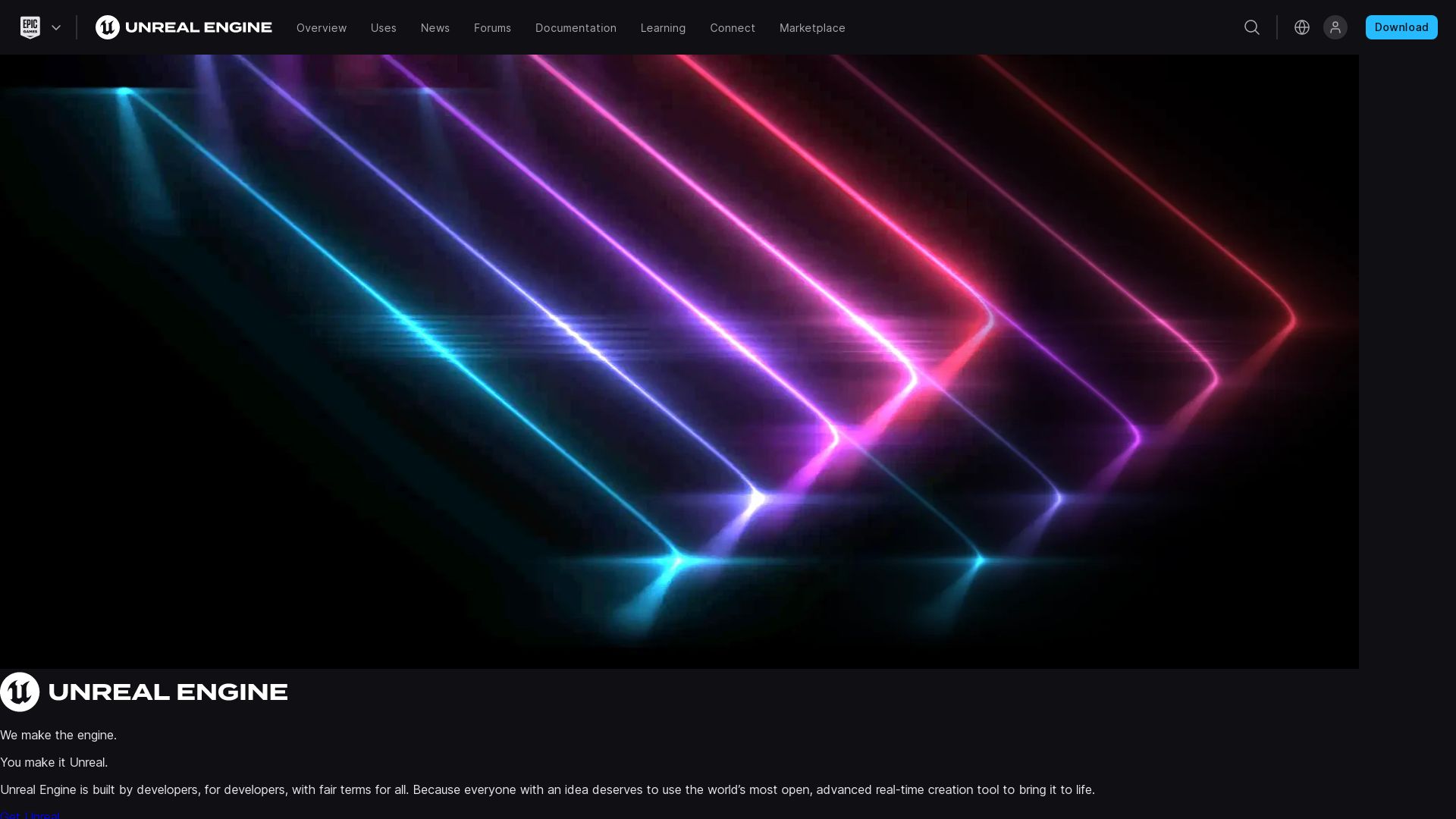
From the technological storefront of Epic Games, a new hero in 3D content creation has emerged – Unreal Engine 5. This software is the epitome of next-gen 3D content creation, designed to deliver a new level of detail and realism in game development.
Unreal Engine 5’s Best Features
- Nanite: A game-changer, Nanite enables the creation of detailed worlds, processing multi-million-polygon meshes at real-time frame rate.
- Lumen: This is a revolutionary solution offering fully dynamic global illumination and reflections. Lumen makes indirect lighting adapt swiftly to changes in lighting or geometry.
- Temporal Super Resolution (TSR): TSR serves as a built-in upsampling system, which enables low-res rendering with high-res pixel fidelity to facilitate smooth 60 fps performance.
| Feature | Description |
|---|---|
| World Partition: | Assists in level management by dividing the world into a grid and streaming necessary cells. It’s a boon for teamwork as it facilitates simultaneous work. |
| Control Rig: | An in-house animation authoring toolset that remarkably reduces round-tripping in the creation process. |
Unreal Engine 5 Disadvantages
- Complexity: For beginners, Unreal Engine 5’s advanced features may have a steep learning curve.
- Cost: Although Epic Games provides free sample projects, there is a royalty fee of 5% of gross revenue once your lifetime gross exceeds $1 million.
Unreal Engine 5 Pricing
The price of developing with Unreal Engine 5 may vary approximately between $35K-$85K. However, the engine itself is available for free, with the exception of the royalty fee applicable once your lifetime gross exceeds $1 million. This fee is conveniently waived for games published on the Epic Games Store.
Unreal Engine 5 Use Cases
Use Case 1: Gaming
Unreal Engine 5, with its intricate feature set, creates an immersive gaming experience, especially in first-person shooter games – a genre where it was first showcased in 1998 with Unreal.
Use Case 2: VR/AR Development
This engine, with its high degree of portability, is also a perfect choice for developers venturing into the fields of Virtual Reality and Augmented Reality, offering compatibility with a wide range of platforms.
Use Case 3: Mobile Game Development
With Unreal Engine’s compatibility covering desktop to mobile platforms, it can be used effectively for creating captivating mobile games. Its C++ development language allows for easy porting across multiple platforms.
O3DE
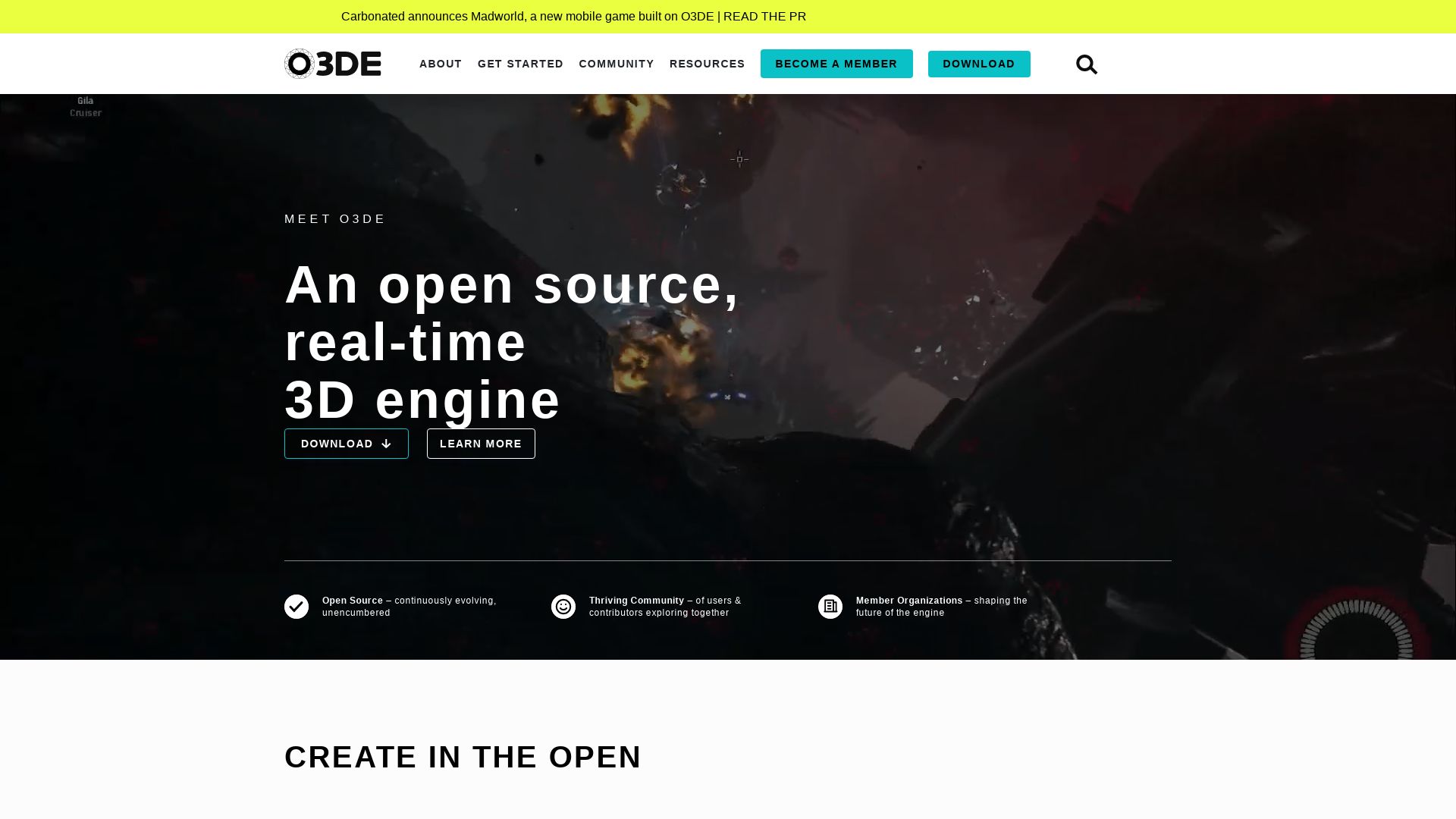
The O3DE, developed by the Open 3D Foundation, allows developers to create high performing, interactive experiences with its open-source, real-time 3D engine. This versatile tool is written in C++, Lua, and Python, providing a flexible dev environment for a variety of applications.
O3DE Top Features
- Modular Engine: Gems, reusable libraries, allow for customization and extension without recompiling the entire engine.
- Scripting: Utilizes Script Canvas or Lua for runtime logic, and Python for extended scripting support.
- Asset workflows: Supports data-driven approaches, simplifying the asset construction process.
| More Features | Beneficial Information |
|---|---|
| Host for Windows and Linux | Provides flexibility in the development environment. |
| Physically based renderer | Enables realistic visuals and graphics for the 3D applications. |
| Support for precompiled gems | Can add/remove functionalities without having to recompile the engine. |
O3DE Downsides
- Despite its rootedness in Lumberyard, one of its popular games, New World, received only mixed reviews.
- Although competitive, still lagging behind industry giants like Unreal Engine and Unity.
O3DE Pricing
The O3DE operates under an open-source licensing system, allowing for completely free use by developers.
O3DE Use Cases
Use Case 1: Gaming
Given its origin in Amazon Lumberyard, O3DE is particularly well-suited for creating complex games with engaging graphics and physics simulations.
Use Case 2: Simulations
The engine’s advanced graphics rendering and physics simulation capacities make the O3DE ideal for constructing reality-like virtual simulations for training or demonstration purposes.
Use Case 3: Asset Creation
Utilizing its data-driven asset workflows, O3DE offers an efficient, convenient space for developers and designers to build 3D assets.
Open 3D Engine

Presenting the Open 3D Engine (O3DE), a remarkable open-source 3D game engine. Crafted by the Open 3D Foundation, a subsidiary of the esteemed Linux Foundation, this engine has been piloted towards stability since its inception in October 2023.
Open 3D Engine Top Features
- Powered and Enlightened by C++, Lua, Python.
- Embraces a vast array of operating systems including Windows, Linux, iOS, Android.
- Boasts a modular structure, standing on Gems – libraries with standard interfaces and assets.
- Supports Script Canvas and Lua for runtime logic creation.
- Flaunts an atom physically based renderer, DirectX 12, Vulkan, and Metal graphics API.
| Function | Feature |
|---|---|
| Physics Simulation | Employs NVIDIA PhysX, NVIDIA Cloth, AMD TressFX. |
| Build File Creation | Utilizes CMake for build file generation, automation and dependency management. |
| Asset Building | Workflow enhancements, prefab overrides, and graph nodes for script canvas. |
Open 3D Engine Limitations
- Limited to the features present in the initial stable release.
- Fully open-source, thereby sometimes requiring professional guidance for complex tasks.
Open 3D Engine Pricing
Riding on the freedom train, O3DE is absolutely free and open-source.
Open 3D Engine Use Cases
Use case 1
For developing interactive 3D applications, O3DE’s physics simulations using NVIDIA PhysX, NVIDIA Cloth, and AMD TressFX offer breathtaking realism.
Use case 2
O3DE’s universal OS support empowers developers targeting multiple platforms such as Windows, Linux, iOS, and Android.
Use case 3
For educators and institutions, O3DE’s academic collaboration with Rochester Institute of Technology offers resourceful asset libraries and helps address O3DE’s feature gaps.
Stride
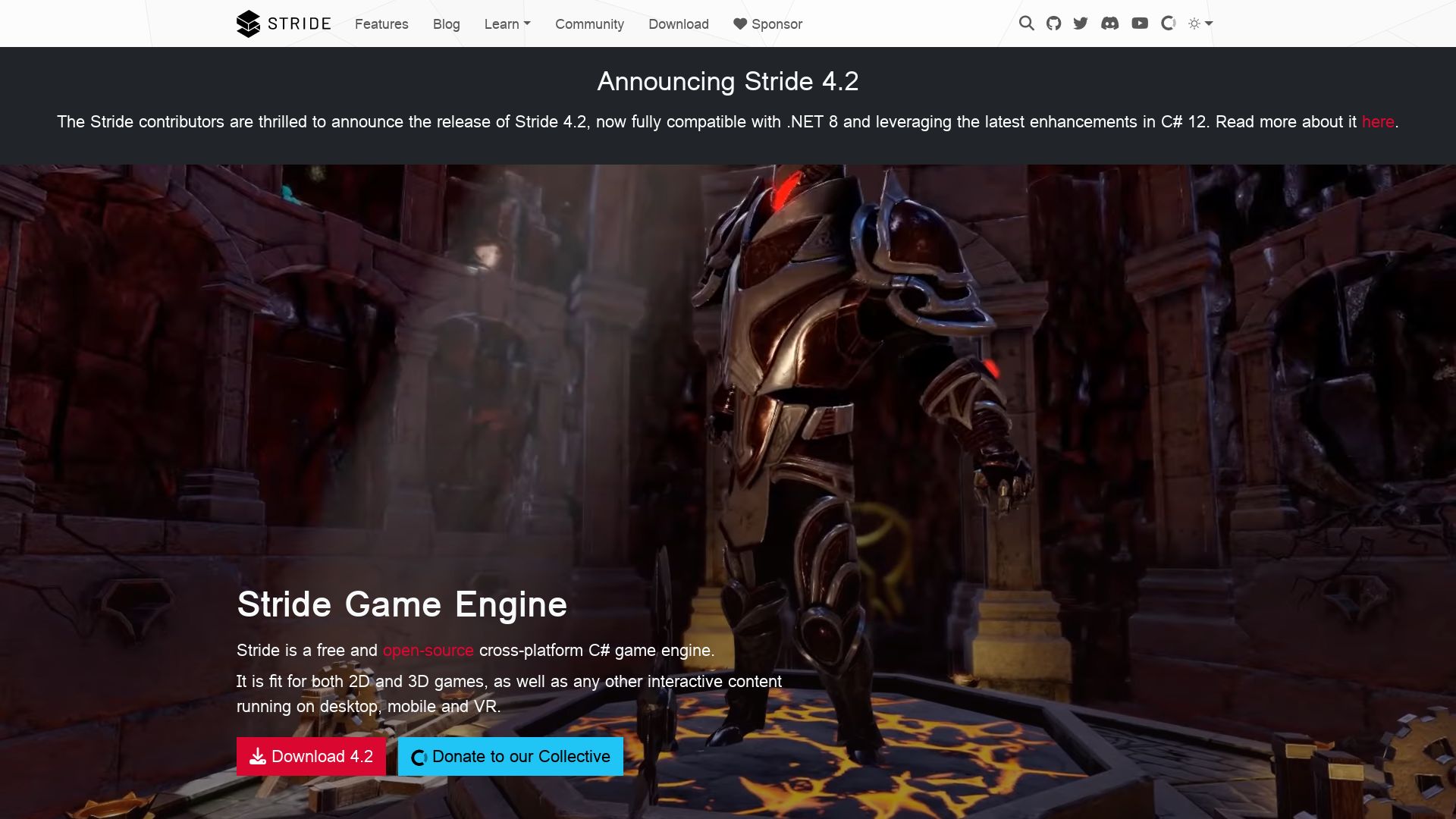
Formerly known as Xenko, and developed by Silicon Studio, Stride is a free, open-source 2D and 3D cross-platform game engine. Its versatile applications range from creating video games for PC, mobile devices to virtual reality. Stride also acts as a 3D rendering engine for the visual programming environment vvvv gamma.
Stride Top Features
- Stride boasts of a C# suite of tools, providing an advanced coding environment.
- A fully customizable shader system and physically-based rendering (PBR) layered material editor offering a ray of photorealistic effects.
- Game Studio, an integrated environment for asset import, scene creation, script assignment, and game running.
- The cross-platform runtime supports iOS, Android, Windows UWP, Linux, and PlayStation 4, catering to a broad user base.
- Stride includes a sprite editor, a scripting editor, and a UI engine enhancing user interaction in game development.
| Feature | Description |
|---|---|
| In-built tools | Particle editor, scene streaming system, full tool-chain |
| Multiple platforms | Support for iOS, Android, Windows UWP, Linux, and PlayStation 4 |
| Community Support | After Silicon Studio relinquished support in 2018, the engine shifted to a community-supported model |
Stride Limitations
- The shift to a community-supported model may affect official support and updates.
- Despite the engine being powerful, it may have a steep learning curve for beginners.
Stride Pricing
Stride is open-sourced and comes without any specific or tiered pricing model. It’s free and accessible to everyone passionate about game development.
Stride Use Cases
Use case 1
Stride serves as an excellent tool for those looking to create cross-platform video games. With universal runtime support, it aids game developers, offering a single environment to build games that run on iOS, Android, Windows UWP, Linux, and PlayStation 4.
Use case 2
Stride can function as a useful 3D rendering engine for visual programming in environments like vvvv gamma, making it a versatile utility in diverse fields.
Use case 3
Open-source projects can benefit from Stride as its engine and editor are both under MIT License, encouraging collaborative contribution and development.
Grant Sullivan
Content writer @ Aircada and self proclaimed board game strategist by day, AI developer by night.





